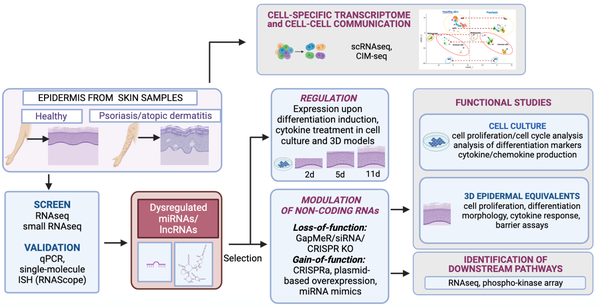Psoriasis and atopic dermatitis
Psoriasis and atopic dermatitis are the most common chronic inflammatory skin diseases. A combination of genetic and environmental factors contributes to the development of these diseases, which share superficial similarities however their immunopathogenesis is distinct.
Description
Psoriasis is characterized by a vicious circle of inflammation in the skin fueled by disturbed interactions between keratinocytes (skin’s epithelial cells) and infiltrating immune cells. Psoriasis is a prime example for the translational revolution in dermatology: our increasing knowledge on the immunopathogenesis has led to the development of new, efficient targeted therapies. Nevertheless, the regulatory mechanisms involved are far from fully known and there is a need for new efficient topical and systemic treatments. We have previously shown that non-protein-coding RNAs (miRNAs and lncRNAs), which are important regulators of gene expression, can contribute to biological processes relevant to the pathogenesis and that their modulation is beneficial in preclinical models.
Atopic dermatitis is characterized by dry skin and intense itch as well as inflammatory lesions arising from a combination of skin barrier deficiency, dysbiosis and mainly Th2-type inflammation in the skin. Better understanding of the interplay between these factors is a prerequisite to develop novel treatments. Our work has shown that ncRNAs are dysregulated in atopic dermatitis skin; however, their roles are still largely unexplored.
Using a combination of patient samples, animal models, cell culture and 3D epidermal models (Figure 1), our group investigates the following research questions:
- Which regulatory non-coding RNAs are dysregulated in chronic inflammatory skin diseases and in which cells?
- Which biologic processes, genes and signaling pathways are regulated by the disease-associated non-coding RNAs in the skin? What is the biological function of the disease-associated non-coding RNAs? What is their mechanism of action?
- Can therapeutic modulation of non-coding RNAs be beneficial in chronic inflammatory skin diseases?
How is the cell-specific coding and non-coding RNA signature in psoriasis epidermis? Which cells interact closely with each other and how are their transcriptional signatures?

Schematisk bild som över...
